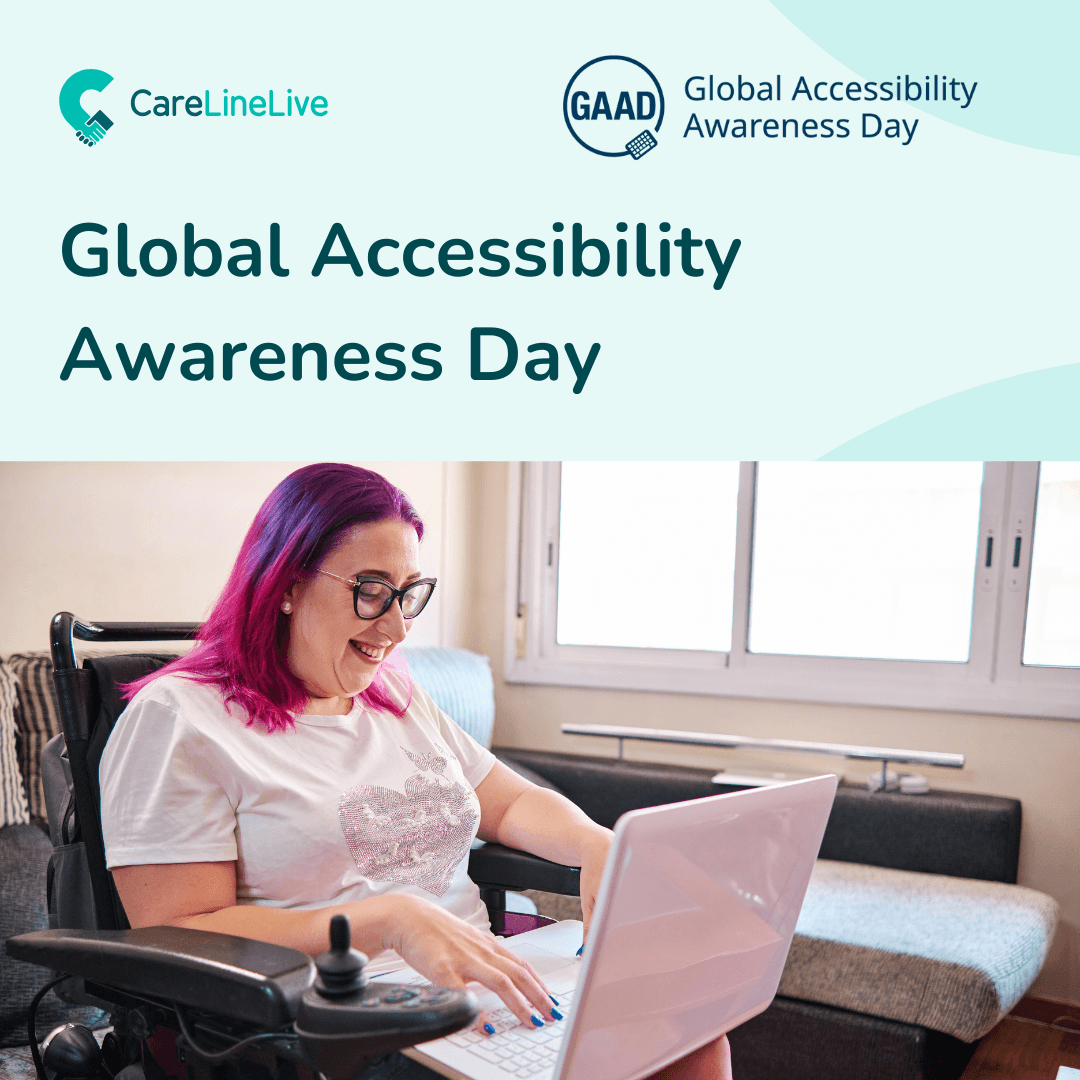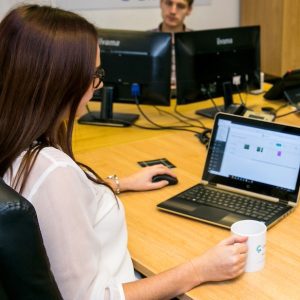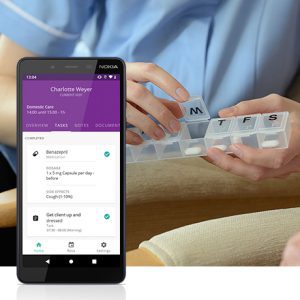Join us on Thursday May 15th 2025 as we celebrate the 14th Global Accessibility Awareness Day (GAAD)! This important day aims to encourage conversations, reflections and learning about digital access and inclusion for the over one billion individuals living with disabilities or impairments.
We are urged to consider the accessibility of technology for everyone, emphasising the importance of adapting technology to accommodate the needs of individuals living with disabilities. This adaptation is crucial in addressing the challenges faced by people around the world in their daily lives.
As society increasingly relies on technology we experience it infiltrating every facet of our lives, impacting everything from healthy eating and banking to our interactions with individuals and organisations that shape our lives day-to-day.
Challenges for people living with disabilities
Individuals with disabilities face a range of challenges in their daily lives, which can impede their ability to lead fulfilling lives. This often includes difficulties in securing regular and flexible employment. This can occur because the technology is not suitably designed to meet individual needs. Consequently, it is essential for software development companies to recognise and cater to the diverse needs of all members of society.
CareLineLive’s product development mantra in relation to accessibility
At CareLineLive, we firmly believe that designing for accessibility provides a better user experience for everyone. When software is designed to be accessible we ensure that it can be used, interacted with, navigated, and understood by users of all abilities. An accessible product gives all users the same quality of experience and can adapt to all users and situations. We apply the Web Content Accessibility Guidelines (WCAG) 2.0 standards to our software reflecting the requirements for perceivable, operable, understandable and robust design.
GAAD barriers to digital inclusion
- Visual
People who are visually impaired need alternative text descriptions for meaningful images and use the keyboard and not a mouse to interact with interactive elements.
Exclusion from technology, along with insufficient digital education, creates significant barriers to digital confidence and competency. Consequently, this can foster resistance within organisations, hindering their ability to successfully embrace change and innovation.
At CareLineLive we try to maximise readability and visual clarity also considering the proximity of information. We enable font sizes to be adjusted and comply with WCAG 2.2 guidelines for contrast to help colour-blind users. We also test with a screen reader. - Hearing
People who are deaf or hard of hearing can benefit from captions for video presentations and visual indicators in place of audio cues. - Motor
People with motor impairments may need alternative keyboards, eye control or some other adaptive hardware to help them type and navigate on their devices.
At CareLineLive we have designed our software to work with keyboard interaction as well as usability with trackpads and other assistive technologies. - Cognitive
An uncluttered screen, consistent navigation and the use of plain language can be useful for people with different learning disabilities or impairments.
At CareLineLive we try to avoid complex language and provide a user experience that is familiar in terms of design conventions and UX (user experience).
Exclusion from technology, exacerbated by insufficient digital education and inaccessible design, undermines not only digital confidence and competence but also cultivates resistance to innovation. This challenge is particularly pronounced in sectors such as social care, where a longstanding dependence on traditional (often paper-based) methods has established further obstacles to embracing digital solutions.
Social care workforce: Reaping the benefits of digital inclusion
Prior to the COVID-19 pandemic, there existed a notable cultural and historical hesitation within the social care sector to move away from conventional paper-based practices. While this may seem like a broad generalisation, it is crucial to recognise that the industry primarily comprises individuals who are person-centric, dedicated to caring for and nurturing health and wellbeing. For many care workers technology has often been perceived as relatively inconsequential.
During the COVID-19 pandemic, an NHSx audit on technology and digital skills within the care sector found a notable 38% of staff voicing concerns regarding the potential for technology to replace human care. Furthermore, some individuals reported feeling stressed as a result of poorly managed technology implementations. The subsequent review underscored several obstacles that impede the enhancement of digital skills and the adoption of technological innovations.
At an individual level, the main barriers were:
- Variation in familiarity and opportunity to use digital technology, this affected people’s digital confidence
- Awareness and knowledge about the range of digital technology available, and a perceived lack of need for digital technology felt by some people with care and support needs and unpaid carers
- Anxiety and stress generated by the introduction of new technology felt by some of the frontline workforce, by some people with care and support needs and also by unpaid carers. These groups expressed concern that digital technologies could replace face-to-face care and support, with potential impact on quality. There was often a related reluctance to work digitally
You can read the full article here.
Current adoption patterns
- Basic digital tools like email and video calling are widely used, though uptake remains lower among care workers compared to administrative staff and health professionals
- Specialised care technologies such as digital care records now serve over 70% of providers, replacing paper-based systems
- Cutting-edge innovations like motion sensors for fall detection and AI-driven predictive care tools are being introduced through government-backed training programs
- Resource limitations: Smaller care agencies struggle with the costs and training requirements of new systems
- Skill gaps: Frontline workers frequently experience a lack of confidence when using digital systems, especially among older age groups or those employed by smaller providers. Currently, there is a concerted effort to implement technology throughout the sector supported by dedicated qualifications. These qualifications empower leaders to advocate for digital transformation within their organisations.
When introducing, using, or even considering new technology, it is important to recognise that everyone brings their own preconceptions, attitudes and experiences. People vary in their knowledge, motivation and enthusiasm and these human factors are crucial to the success of any improvement programme.
Everett Rogers, a pioneer of diffusion theory (which explores how new ideas and technologies spread), observed that with any innovation, there will be “early adopters” and “laggards” at either end of the spectrum. However, most people sit somewhere in between and are willing to engage when they can see clear benefits.
Research conducted for the NHS Leadership Centre reveals a consistent trend regarding major change initiatives, categorising staff into three distinct groups:
- Early adopters and enthusiasts (about 20%)
- Pragmatists—those who prefer to wait and see but will support change once it proves effective (about 50%)
- Sceptics and traditionalists (about 30%)
As a company we have responded by designing logical and intuitive software interfaces that are easy to pick up and operate. Our systems are designed for ease-of-use not just by those who need may additional support but also by carers and care coordinators that may be technophobic and inexperienced in the use of technology.
Drivers of change
The pandemic forced rapid adoption of communication technologies, while recent government initiatives focus on leadership training to scale innovations like video telecare and automated documentation tools. However, disparities persist with care workers showing lower enthusiasm for full digital transformation compared to managers.
Government initiatives are playing a crucial role in advancing digital social care records, effectively addressing the technical skills gap and encouraging the adoption of assistive technologies across health and social care sectors.
Through leadership training and the implementation of predictive care and motion sensors these care technologies are designed to ensure individuals receive optimal support within their communities. This approach not only aims to prevent unnecessary hospital visits but also alleviates pressure on the NHS. Furthermore, it aligns with the government’s 10 Year Health Plan, which seeks to modernise health and social care for future needs.
Guidance frameworks are essential for advancing care technologies, enabling individuals to receive optimal care within their communities and minimising unnecessary hospital visits. This approach alleviates pressure on the NHS and aligns with the government’s 10 Year Health Plan, which aims to prepare health and social care for the future.
The government press release on 9th April 2025 reinforces the government’s commitment to build a social care workforce that is digitally competent and confident.
Digital inclusion in the workplace
Digital inclusion in health and social care has presented a significant challenge for individuals who feel overwhelmed by the prospect of change. Many are hesitant to embrace technology or consider positions where the adoption of technology is essential. However, such roles are becoming increasingly scarce, leaving workers with little choice but to take the leap and confront the misconception that technology is difficult to use.
The adoption of technology by home care workers showcases a blend of advancements and hurdles, highlighting the uneven pace of digital transformation within the sector. While some outdated practices and a hesitation to embrace change may cause certain digital dinosaurs to resist the integration of technology, recent initiatives along with necessities driven by the pandemic are significantly hastening the modernisation process.
The landscape is evolving as domiciliary care services increasingly acknowledge the advantages of embracing technology. This shift not only streamlines tedious paperwork but also enhances communication and improves outcomes for those receiving services. In the realm of home care, staff working alone are discovering that they are significantly more informed and engaged in their professional roles.
Here’s what some users of CareLineLive are saying about the advantages of technology in their roles.
“I was really against CareLineLive to begin with but now I think it’s absolutely brilliant. I’m not very good with phones so I thought it would be hard to use but I’m surprised at how easy it is.
CareLineLive has made life a lot easier – I couldn’t even read the handwriting of some of the other carers. It’s a big benefit having the notes available digitally.
Everything is documented, at the office they can see what I’ve written. And if I have a day off I will always read up what has happened with the client from whoever else was looking after them.”
Salmah Bibi, Carer at Kirklees Choices Homecare“CareLineLive is really convenient. I’m not a techy person at all – I’m more of a pen and paper type of girl. I found it really straight forward and easy to use. I can look at things prior to visiting a client and it’s helpful to have access to all that information whenever I need it. Without it you can feel quite overwhelmed by a new task or new client – it’s really handy to have the app available.”
Sarah, Carer at Nurseplus“When I first found out that we were going to use technology I thought ‘here we go!’ I don’t do social media like Facebook or computers really, so it was daunting. My children are good but I only do phone calls or texting. I wasn’t too happy, but its been easier as we’ve gone along and with the recent changes especially with the new colour coding and the app improvements, it’s brilliant! In fact I help the other carers with the app. I always say that I’m not good with technology so try it out on me to see how easy it is. If I can do it anyone can do it.”
Rita Guarina, Carer at Choices Homecare“I was completely against it at the start and was unwilling to embrace it. Now I feel silly because it has all worked out for the best.”
“CareLineLive makes things a lot easier as we have the info before we go into someone’s home.”
“It is so much easier to see where you are working and updates made on my run.”
Carers at South East Trust in Belfast“At CareLineLive we speak to a real human who picks up within a minute of call connecting. Always very knowledgeable and experienced with added value of speaking your language (no tech talk misunderstandings or barriers).”
Roger Bayliss, Care 2 U Ltd“The team have found it a simple and efficient system to use. Plus, they like that they can easily make notes about clients, which can be communicated back to managers in real-time.”
Clare Flynn, Owner, Brightening Lives“CareLineLive is a simple-to-use care management system and its so visual so you can easily see where there may be some complications. Carers have so much more information to deliver better care and make it more personalised. CareLineLive does give them more time to care. It’s great.”
Johanne Stanley, Owner, Halifax Care




